A hole can be a portal, a passageway, a point of penetration, an injury, an orifice, a site of leakage. The holes in Linda Leslie Brown’s latest exhibit take the viewer not to Wonderland but a dumping ground. Unwanted items are reincarnated: a cookie cutter, aquarium greenery, a circuit board, the bottom of a Solo cup, a plastic capsule from a supermarket vending machine. Photographs cannot adequately capture these sculptures. They morph from angle to angle, evading total comprehension. Installed on risers that ascend in height, they appear like contestants in a bizarre pageant.
More Holes, on view at Kingston Gallery through May 29, is a mature collection in both method and result. Brown constructs these oddities from the refuse of consumer living. “Boxes of treasure”—many crammed with finds from her husband’s morning dog walk—populate her studio. “I have a lot of crap,” she says. Installations were her previous forte, but a desire to work small (combined with more practical concerns about storage) pushed her toward the genesis of these odd little forms. As a reflection on “porosity and vulnerability,” Brown’s sculptures recall the words of theorists Annemarie Mol and John Law: “The body…is not a bounded whole: its boundaries leak. Bits and pieces of the outside get incorporated within the active body.”
Permeability and potentiality are frequently summoned in Brown’s studio, where objects are apt to lose all stability through a Kali-esque process involving both destruction and creation. Junk must be fragmented before it can be subsumed into a new, fractured whole. Brown works on the pieces from “all sides, including the bottom,” producing uneven, diversely textured work like Mother or Rushin’. “It’s important to me that they continuously change as you move around them,” Brown says. To borrow a line from Ovid, her “intention is to tell of bodies changed.”
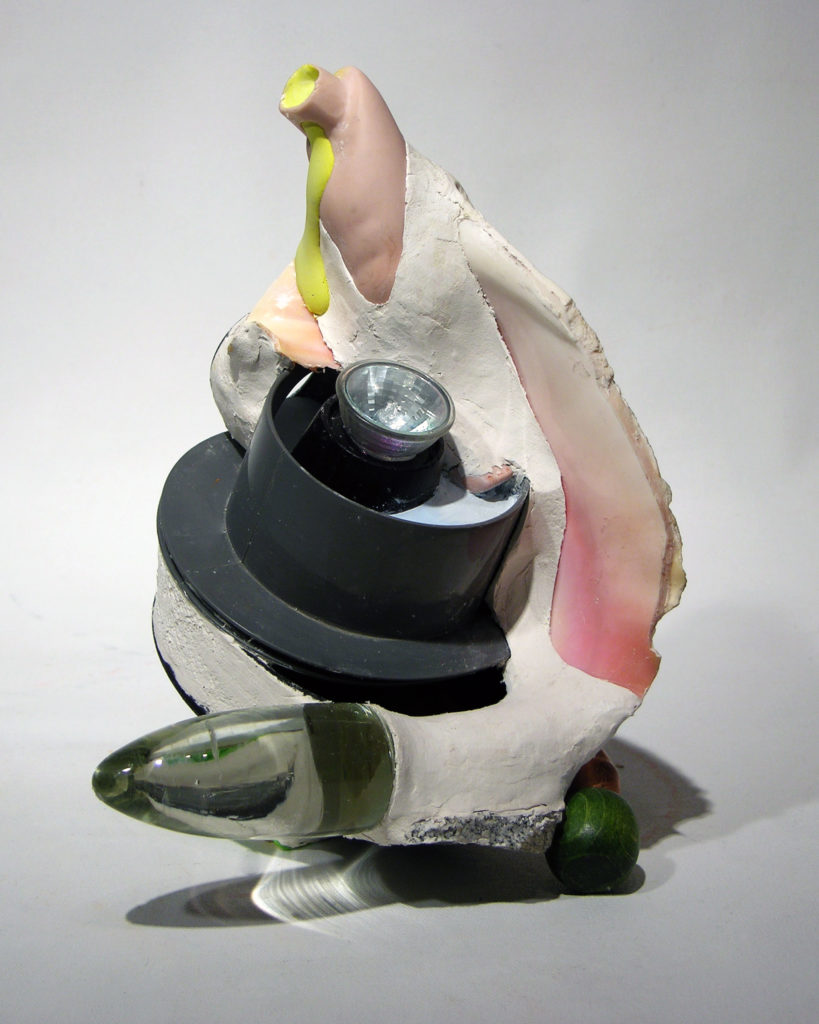
Linda Leslie Brown "Mother Shell" 2016
Despite their origins in detritus, the sculptures are not without their formal charm. Brown achieves a surprising tonality through her hodgepodge materials, from polished, pearlescent pinks to the unmistakable red of a Christmas tree bulb. Pigment, plaster, Paperclay and “a variety of adhesives and attachments” cohere these curious structures. These sculptures employ an abstract language that “translate[s]into body-like subject matter" Brown says. They don’t render the body exactly, but they trace the perimeters of embodiment. A palette of primarily whites and muted earth tones, with the recycled objects providing scraps of saturation, furthers the bodily associations.
Brown says her sculptures concern intimacy: “how we touch one another with our eyes and also with our bodies.” This touch is evident in the worked-over Paperclay and plaster surfaces. Indeed, it’s unfortunate that the viewer can’t actually enjoy the haptic qualities of these pieces. Perhaps their suggestiveness suffices. As Erin Manning writes in The Politics of Touch, “Might we conceive of touch as a reaching out toward the everyday, toward the textuality and the movement of our bodies, of our lives, of our diverse experiences on the earth?” She contends that touch operates on levels virtual and actual, “toward a concept of the senses that signifies not the biological body but the body’s imminent excess.”
Brown’s amalgamations of ‘skin’ and waste visualize this excess as if it were barely contained in a material body. Her sculptures refuse to conform to the viewer’s expectations of coherence. They represent bodies in incessant flux, entities with numerous options for future being and shape. A piece like Odd Jobs juts in different directions, its appendages unsure of what form to take next. This is not to suggest that the sculptures look hastily put together. Indeed, they display a formal intelligibility and refined sense of juxtaposition, qualities that are clearly the products of Brown’s seasoned approach. Yet the sculptures’ gestural attributes imply an agenda beyond artistic intent, one of unending movement and metamorphosis.
Brown says some viewers have found the work “disturbing”—the limb-like protrusions and dull pinks could be monstrously fused organs—but on the whole, people seem to “appreciate the energy.” Brown’s convinced the sculptures project this liveliness of their own accord: “I don’t. I have to say that. I think I have an OK sense of humor but I don’t set out to make these funny. They surprise me all the time.”
A certain jouissance animates these occasionally ugly creatures; their whimsy is disarmingly raw. Here is patchwork, smashed-together flesh, an abjectness that Brown finds relatable rather than clinical. Her sculptures ask that we interact with the less desirable features of embodiment, the constant mutations which affect us all. The curvy Fashion Week, for instance, struts its cumbersome form proudly, wearing a hat of wire mesh and an indeterminate pink substance. A hole gapes in its chest, acting as a possible entryway into its hulking beauty.
Brown cites Nicole Eisenman as an artist who “in the recent past [has]helped to bring attention back to the body in the context of art.” To quote one New York Times reviewer, Eisenman’s paintings are full of “unruly flesh” and “anarchic laughter.” Those descriptions could easily fit Brown’s work as well (though her sculptures seem to chuckle more reservedly). Eisenman herself has discussed the importance of embodiment in art. “The haptic experience in look[ing]-feeling enables us to embody the meaning of a work of art. It is so cool that a body can communicate and pass on knowledge to another body via art,” she wrote in a 2014 interview.
Brown agrees that “there’s a lot we can’t fathom about that relationship [between mind and body]. And that can be a fit subject for art.” The physicality and movement of her process is inherited by her sculptures, who in turn ask the viewer to respond with their own body. The festive Stroll seems to ask the viewer for a dance, while the sharp angularity and open arms of Pique with Citrine could suggest either a threat or a hug. Like Eisenman’s distorted figures, Brown expands our conception of what the body can be, revealing where the theoretical and material overlap.
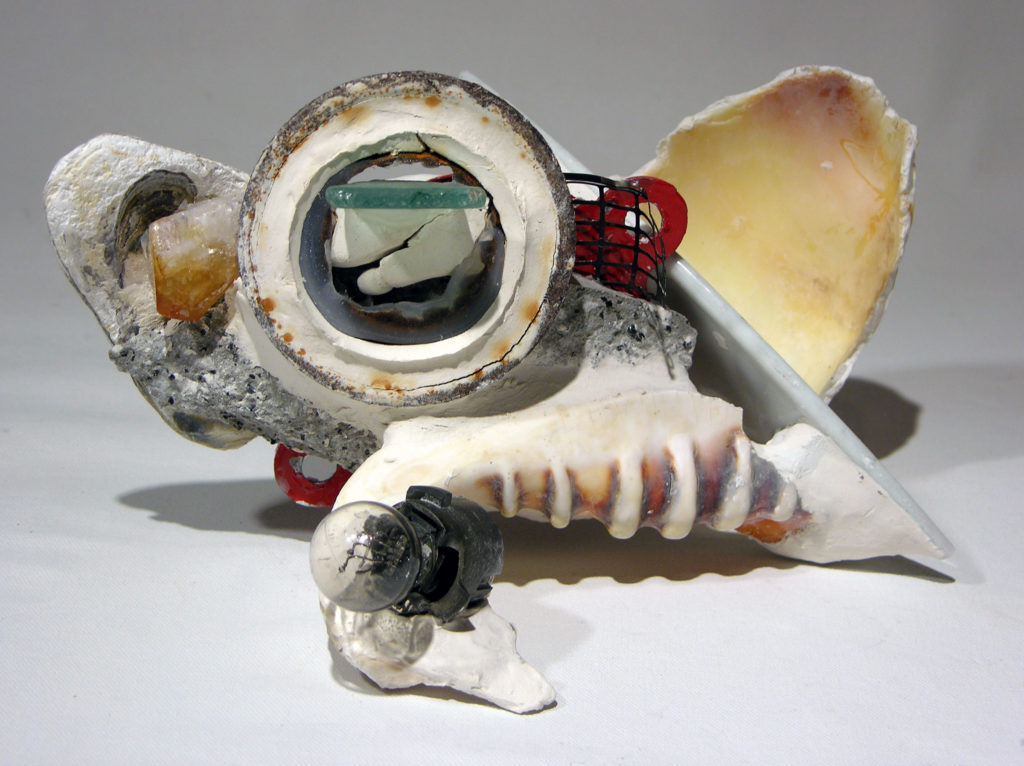
Linda Leslie Brown "Pique with Citrine"
But as the immanent plane provides space for both life and death; so, too, do these sculptures evoke atrophy and decay while assuming hilarious and nimble poses. One might imagine these sculptures caught between Eros and Thanatos: full of a certain humor and life, but ever inching toward the inorganic, driven by what Brown calls the “horrifying permanence of plastic." Topiary visualizes this instinctive self-destruction, as an ‘arm’ of fake moss and wood strives to separate itself from a plastery white torso—a potential hole in the making. Says Brown: “We go through so many transformations throughout our lifetime, and we’re all riddled with holes. Figuratively and literally. We’re all very hole-y.”
An acceptance of this fact seems untenable within the “neoliberal, positivist” perspective prevalent among Americans, which suggests that “everything every day is getting better and better,” Brown says. “But a lot of times you have to tear things down. Or life itself will tear you down. And that needs to be honored as well.”
More Holes is a tribute to the unfinished body. As Mol and Law argue, all human bodies fit this criterion: “You do not have, you are not, a body-that-hangs-together, naturally, all by itself. Keeping yourself whole is one the tasks of life. It is not given but must be achieved, both beneath the skin and beyond.”
Are Brown’s sculptures these disintegrating bodies? Vessels whose shapes didn’t hold? Perhaps something else entirely—tokens of ecological catastrophe? The lack of an answer is what makes More Holes so compelling. A question posed by Manning applies here: “Is this too abstract? Or is it perhaps not abstract enough for the lived abstractness that is the sensing body in movement?” Brown’s mischievous forms are just outside the human, yet they’re familiar enough that one might feel a strange but kindred bond with their secondhand, shifting flesh.
More Holes is on view through May 29 at Kingston Gallery.
- Linda Leslie Brown “Rushin'” 2016
- Linda Leslie Brown “Pique with Citrine”
- Linda Leslie Brown “Mother Shell” 2016

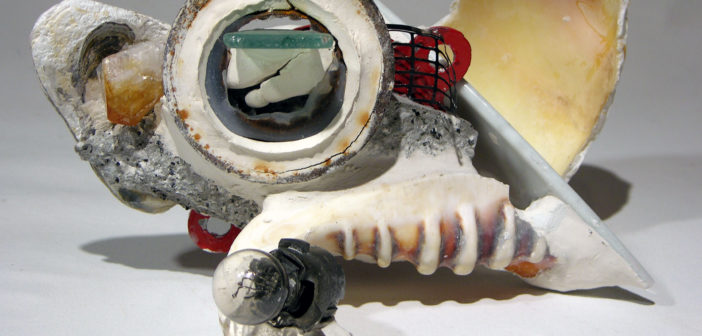
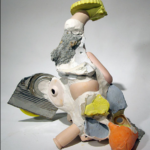
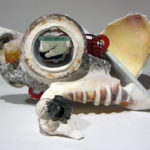
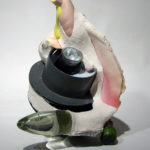

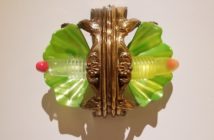
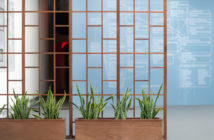
1 Comment
I really liked this piece on Linda Brown’s work. I saw the show and I thought your piece was very thoughtful. Familiarity in art, without a direct representation of reality ( or actuality) is very interesting. It has a poetry inviting the viewer into the conversation. This unfinished conversation can go along way. Thanks for writing and congrats on your critic award for your hard work.